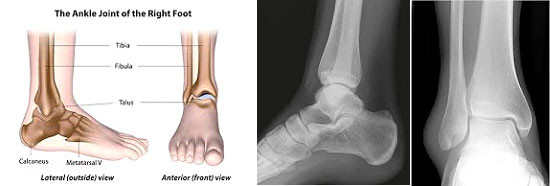

Ankle joint formed by 3 bones tibia and fibula at upper end and talus at lower end. It is hinge type joint and contains fluid inside (Fig-1). It has only two movements; which makes the ups and down movement of foot. It bears whole body weight while walking, running and jumping.

This a painful condition of ankle due to damage of articular cartilage. Usually presents with pain stiffness and swelling of ankle joint after activity. Sometimes a constant dull pain and swelling may persist and aggravation can happen on activity.
Degenerative arthritis in ankle is not as common as other joint like knee, hip and small joints of hand and foot. Most of the time it is secondary to a trauma, infection or a systemic disease. After trauma articular cartilage may get damaged. Post trauma instability of ankle or malalignment of ankle or lower limb can cause uneven weight distribution on ankle cartilage. Both the direct injury of cartilage and uneven weight distribution cause thinning of cartilage and arthritic changes developed gradually. In response to cartilage degeneration and response excessive joint fluid may produce to increase the lubrication of joint and reduce irritation. Tissues around ankle also get thickened secondary to this irritation. Both these factors cause swelling of ankle (Fig1). Swelling cause stretch of the tissue around ankle. Both tissue stretching and cartilage loss cause joint instability. In response to instability excess bone formation happens around joint margin to maintain stability. All these changes can be evident on x-ray as bone spur or osteophyte, narrowing of joint space and cyst deep to joint surface as evident of cartilage thinning and malalignment (Fig2).

Ankle arthritis can be or primary as a part of generalised osteoarthritis or may be secondary due to injury or inflammatory arthritis
The main and early symptom is pain around ankle, lower part of shin bone or up to middle of foot. It may be intermittent related to activity or constant dull aching or sharp & instant like impingement. With progression of disease swelling, stiffness, crepitus, joint instability and limping can happen. One should visit a specialist foot and ankle surgeon when symptoms hampers daily activity. X-ray is the gold standard for diagnosis but CT scan and MRI may need in special circumstances. Blood investigations are done to rule out underlying systemic disease.
Treatment options are conservative or surgical. Conservative can be lifestyle modification or medical management
